March 31st, 2012
| 3 Comments »
When I was 15 or 16, my Mom broke her left elbow roller skating. Outside of the fact that my MOM -gasp!- was roller skating (and apparently getting rather cocky about it) she happened to be left-handed, and in breaking her elbow, this rendered her incapable of doing much of anything. She lamented one day, as I helped her in the kitchen, “I wish I had learned to use my right arm more.” and somehow this struck a chord with me, as did her inability to manage even the most mundane of daily tasks.
It’s been in the back of my mind since then to train my hands to work equally. Although my left handed writing looks like an overly caffeinated six year old, and my knife skills in my left hand are nothing compared to my right, I can whisk, scoop, stir, twist, grind, mix and pour from either right or left. I can reach and function and do just about anything needed during the course of my day without having to switch gears, hands or mindset.
There is always more that your body can do, when allowed. If you’ve learned how to type on a standard keyboard, then you can teach your non-dominant hand to do any number of things. Even though one side of our brain dominates, and we develop a set of skills with that dominant hand, there is far more that one is capable of if you’re willing to put your mind to it.
That goes for recipe usage too. Recipes are not cut in stone; they should serve as a guideline, a base from which we can expand exponentially in many different directions. I love recipes because someone else has already done most of the work for me, but I am free to remove this and substitute that, increase this or decrease that or look at how it comes out in one form and think “I know this can be better.” and then trust that my skills can take me there. These skills have been especially useful in the re-development of this incredible Red Rice Pulao.
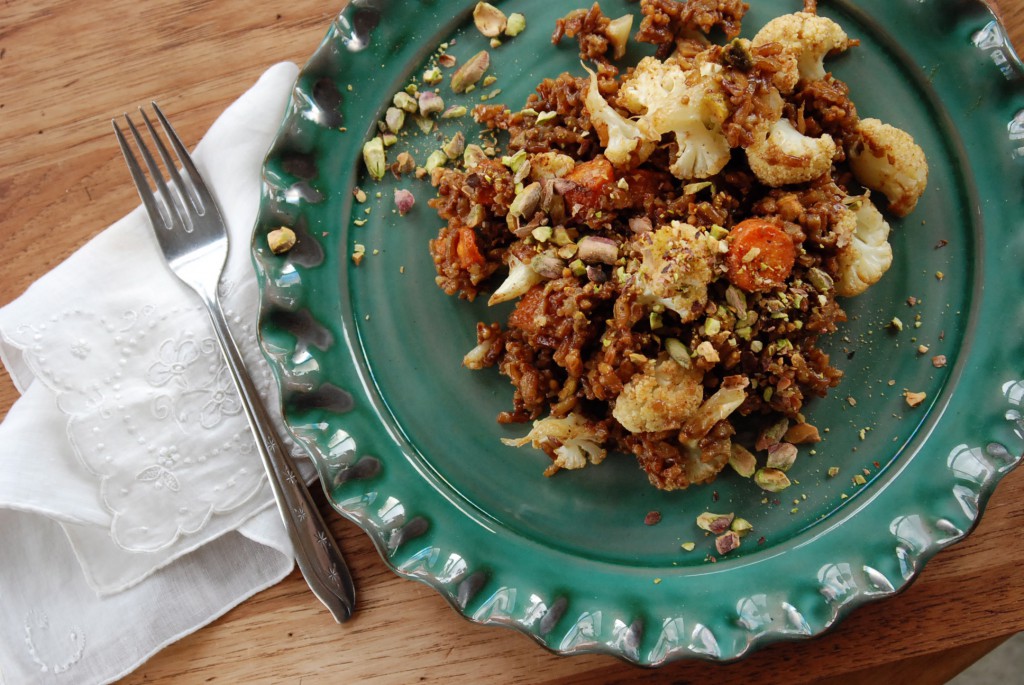
The origin of this recipe comes from Robin Asbell‘s New Whole Grains Cookbook, which, in a soft yet grand way simply changed my life in 2008. Long before the intense embrace by food lovers of all things whole grain, I’d run through a bookful of recipes using quinoa, millet, bulgur and various rices, finding great things to love about these simple staples. Grains are one of the easiest foods to work with in any kitchen, and require no special treatment. Particularly fond of the vibrant rices available, this Red Rice Pulao made for an chewy and delicious experience, and like many wonderful recipes on this blog, I simply posted it once and never went back. What a mistake.
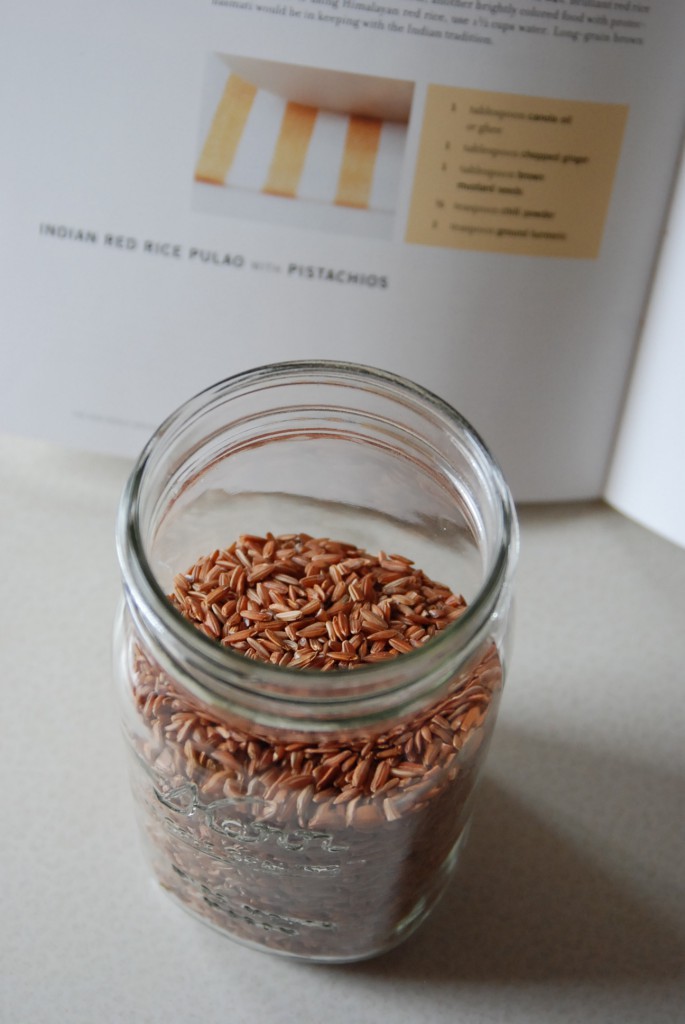
Because that means no one’s ever going to see it, as really, does anyone look in to the archives of a food blog? Rarely. And I loved the recipe when followed to a ‘T’. As I thought about it again, with more capability to be flexible in my cooking, I decided a second go of this dish was in order and am I ever glad I stepped up and made a few changes because this 2.0 version is light years better than the original. No offense to Robin, but the very task of cooking is to learn to feed oneself in the manner that makes you happiest. No cookbook author outside of us knows what makes us happy; only we do, and we owe it to ourselves to learn just enough kitchen skills to take the humblest of foods, such as rice and vegetables, and make them extraordinary. Let the recipe author be your guide, but let your imagination, your tastes and your skills drive you to cook with instinct instead of blind faith.
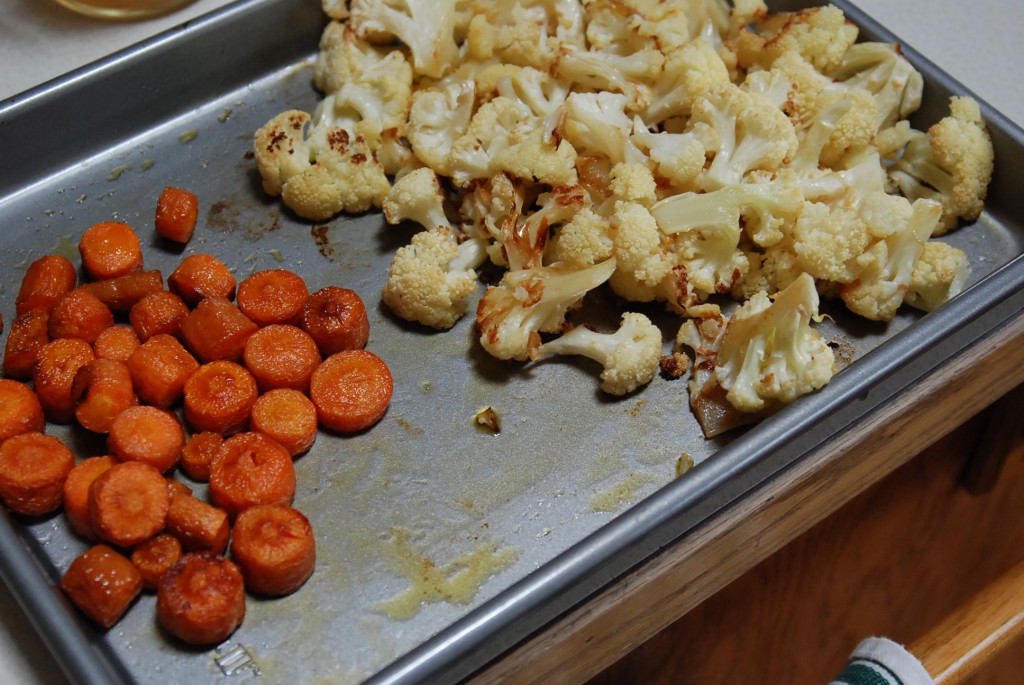
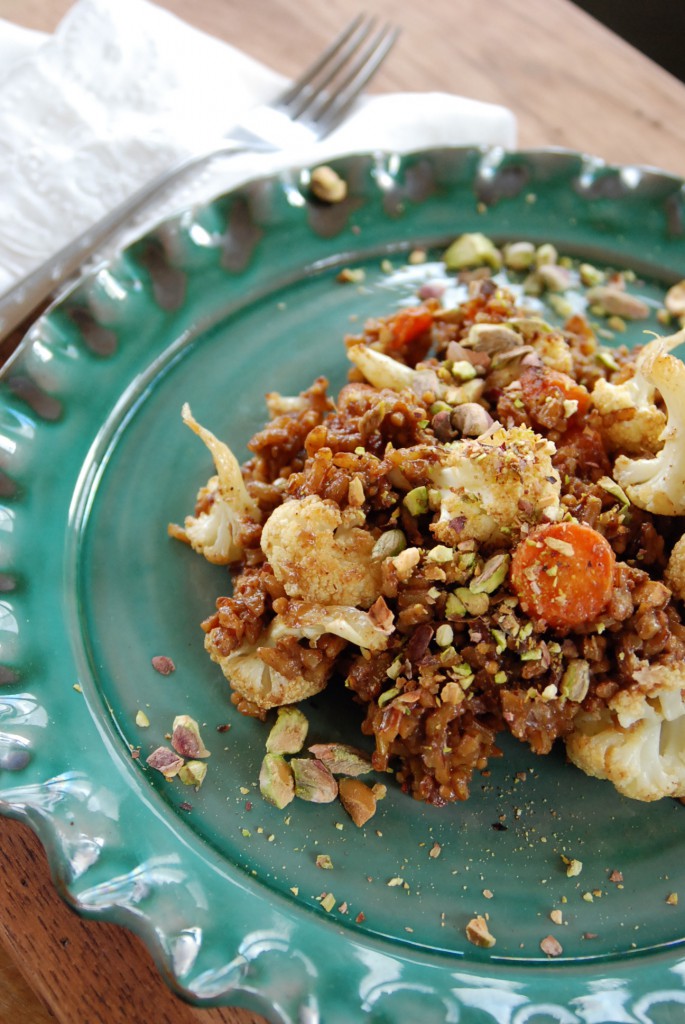
Task-wise, this has a few moments of chopping and prep, but largely you are passing a great deal of idle time as rice simmers, and vegetables roast, while heady fragrances take over your home. This isn’t high-tech stuff here; with the heat of an oven and the magic alchemy of boiling water with rice, you can make an exceptional dish that tastes far more grand than it’s humble beginnings. If you’re unfamiliar with red rice, it’s an intensely chewy rice, often found labeled as Himalayan Red Rice, or Wehani. Properly cooked, it takes up to an hour, all hands off. Finished, it’s a really hearty and satisfying grain, deeper in flavor than brown rice, not as earthy as wild rice. This dish is easily a main course, or can be eaten as a side with any number of proteins. I can vouch that it’s especially good with grilled pork tenderloin.
Here’s where you get to decide what you do with this recipe, because if you want, outside of making the rice you can experiment wildly, with everything else. Instead of carrots and cauliflower, add whatever vegetables you have on hand, or swap almonds, walnuts, pecans or peanuts for the pistachios. This is your base, and when you read through it, your tastes will direct you, just as they should. Trust those instincts. And enjoy.
Red Rice Pulao with Roasted Vegetables
1 T. oil of choice
1 T. chopped ginger
1 T. brown mustard seeds
1 shallot, finely chopped
1/2 t. chili powder
1 t. ground turmeric
1 c. red rice or brown basmati rice
2 c. water
1 T. brown sugar
1 t. salt
2 T. lemon juice
1 head of cauliflower, cut to bite sized pieces
2 medium carrots, sliced
1/2 c. shelled pistachios or toasted slivered almonds
In a 2-qt saucepan, heat oil briefly and add ginger, mustard seed and shallot. Cook for a few minutes, until the ginger is fragrant and the seeds are popping slightly, then add chili powder and turmeric. Stir it up well and cook for a few seconds until the smell is amazing. Add rice, water, brown sugar and salt, stir it up good to combine it all and bring to a boil. Cover tightly, reduce heat to low. The amount of time needed to cook the rice will depend on what rice you use. Test the grains after the time specified on the package, and adjust to your personal taste. Allow to cool slightly. If you are using a true red rice, be patient with it. The time required for me to make mine was slightly over an hour. And every minute was well worth it.
While the rice cooks, heat the oven to 400°, and toss the vegetables with a bit of oil and salt. Since these two cook differently, I put the cauliflower on one pan, the carrots on another and roast until each are tender, shaking the pan often, and stirring to insure even browning. They can hang out in their finished state, until the rice is done.
If you love a good deep flavor for pistachios, take a few minutes and toast them in a skillet over medium heat. It’s well worth it, and that rice gives you plenty of time.
When the rice is done and cooled, dump it all in a large bowl and add the roasted vegetables. Toss together gently and add a few tablespoons of those nicely toasted pistachios. Toss a bit more, taste and add salt and pepper if you wish, then serve it, topped with more pistachios. This dish is good whether served cold, hot or at room temperature. You can garnish it with chopped scallions too, for a bit more flavor.
February 10th, 2012
| 4 Comments »
There is something so perfect about a pot of soup, one that steams and seems to sing from the stovetop, humming it’s warmth throughout my kitchen, through my skin and right in to my bones. I feel the need for soup, sometimes as deep as the roots of my hair and permeating outward, and as any good Midwestern girl knows, when the cold winds scour you down and the light is so flat and gray and weak that it makes you weary and drawn, then soup, in all it’s aromatic glory and flavor, can be a shot of lifeblood that runs through you, chasing the chill away.

Soup has but a few simple secrets to making it shine, such as taking some time to caramelize the vegetables to form a flavor base, a good broth or stock to add more depth and a shot of love, really, to not rush the process. But good soup really starts from need. Or craving and desire.
I used to not be all that good at making soup, mostly because I just didn’t understand why a recipe that looked so simple could often turn out so darn wrong. I wanted depth, a rich flavor that penetrated the spoon and it’s contents, making it something so much more than broth and vegetables. All I really needed was a bit of patience, a lot of practice and tad more salt. Don’t be afraid of a shake of salt over that simmering pot, as it is the one ingredient that can transform a simple pot of soup to one that shimmers it’s warmth right down to your toes.
This Minestrone soup, as all Minestrone soups go, really has no clear outline, no real etymology. It creates itself for the most part, out of what you have on hand, and what you like in your soup. Or, like me on this particular cold January night, it leapt from under my hands out of sheer need. I couldn’t get warm, couldn’t shake a chill that had settled in my core like a wicked internal frost. Somehow, this chill and it’s accompanying rattle in my brain sounded like it was saying, over and over “Make Minestrone!” and I moved, on automatic it seemed, from fridge to stove to cupboard, seeking and searching ingredients. There were the green beans languishing in the drawer and in dire straits, there was Pomi tomatoes (my favorite packaged tomato- so amazingly fresh and flavorful) and there were thick, deeply orange carrots, fat tear-jerking onions, a partial box of orzo, a few zucchini beginning to look slightly sorry for themselves, just enough kale, a bounty of fresh oregano and parsley. And while the fragrance filled the house, and the soup simmered it’s coherent and rhythmic blup-blup-blup on the stove, a quick search for dunking material in the freezer yielded a container of croutons, spiked with herbs and olive oil, that I’d made from a loaf of stale semolina bread. Did I mention another key ingredient to perfect soup just might be a touch of serendipity?
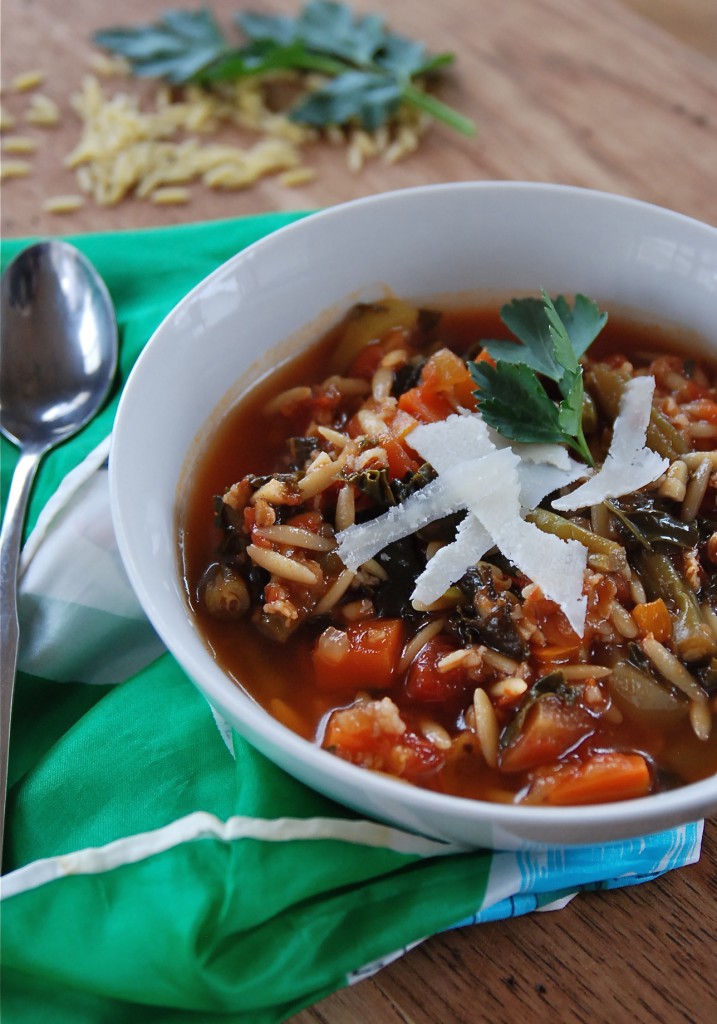
Minestrone requires little of the hard and fast rules; you add what you’ve got, really. What is in season, what is available, what it is you like. It needs a good tomato-y base, without a doubt. But beyond that, it lives for your interpretation. Thick or thin, meat or not, one, two or three vegetables or a whole produce aisle of them, pasta, legumes or rice- it’s all up to you. This version that served to warm my very cold, rattling bones on that damp, chilly night made light of too many singular remnants from the fridge; bits and pieces of plans that maybe fell through or were forgotten, or the one too many of any vegetable that hadn’t been used up yet. It had oceans of freshly chopped oregano and parsley tossed casually over it all, with thick shavings of sharp parm-reggiano. It was like planning a party at the last moment, not so confident of how it will all turn out and right in the middle of it, you realize that everyone in attendance has created an impeccable presence that elevates the whole of it to something utterly sublime. Well, that was my Minestrone that night; a delicious party in a stockpot, gathered with fingers crossed. My intensely perfect Minestrone.
Rounding it all out were the crunchy croutons, oiled, herbed and perfect for soaking up the broth. Beyond that, my perfect soup needed little else but a spoon, a quiet table with two smiling handsome faces, because no day in my life is complete without it ending right there, with them. The darkness settles, chasing out the light with violet and gold tones. The first spoonful I lift easily helps me cross the threshold from day to night, pushing the cold away, warmly coursing through me. There is a sigh, with half-closed eyes, a look and a feel that says “Perfect. This is just what I need.”
Kate’s Minestrone
1 large onion, diced
3 carrots, peeled and diced
3 celery stalks, with leaves, diced
4 cloves garlic, minced (adjust to taste, I am a garlic lover)
2 small zucchini, peeled and diced
1/2# fresh green beans, cut to 1/2″ pieces
1 bunch fresh kale, rough stems removed and chopped (sub chard, collards, or spinach)
1 32-oz pkg Pomi Tomatoes (use equivalent of your choice)
1/2 c. Orzo pasta (use small pasta of choice)
1/4 c. bulgur (optional, but I like the heft and nutrition it adds)
1/4 c. fresh chopped parsley and oregano (basil and thyme are also good)
Parm-Reggiano shavings
In a large stockpot, heat a small amount of oil and add the onions. Cook over medium heat, stirring occasionally, for about 5 minutes, or until the onions are opaque. Add the carrots, celery and green beans and cook, stirring, until the vegetables begin to brown a little, maybe 10-15 minutes. Moderate the heat to prevent them from scorching.
Add the garlic and a pinch of kosher salt. Stir to incorporate and cook for a few minutes until it’s wonderfully fragrant. Add the zucchini and the tomatoes and a quart of broth or water. Bring to a simmer and cook until the vegetables are tender enough to pierce with a fork, but not completely soft.
Add the kale, the pasta and the bulgur, if using. Depending on what pasta shape you use, cook until the pasta is al dente. Taste the soup and season with salt and pepper. Make sure the pasta is cooked, but also remember that it will continue to absorb liquid as the soup sits.
Ladle soup into bowls and top with a sprinkling of the fresh herbs and some shavings of cheese. Serve with a good bread, if desired.
RECIPE NOTES: This soup is wide open to interpretation, and can be modified in a multitude of different ways. Brown some good sausage and use the fat rendered to cook the vegetables for an added punch of flavor. This was a favorite way to make this soup back in my meat eating days.
Legumes can be added to this as well, and most Minestrone soups have them. Use a good quality white bean, such as Great Northern or Cannellini. Chickpeas would also be a good option.
As is the case with most soups, it develops a lot of flavor as it sits overnight in the fridge, but it will also absorb a lot of liquid in to the pasta and the bulgur (if you use the bulgur). Adding a little water to the soup before reheating will help loosen it.
Linking up to Soupapalooza 2012!!
“Come join SoupaPalooza at TidyMom and Dine and Dish; sponsored by KitchenAid, Red Star Yeast and Le Creuset”
August 30th, 2011
| 10 Comments »
Knife skills. It doesn’t just mean that you can hold a knife and cut an onion. It has nothing to do with being able to avoid cutting yourself. And it isn’t even about knowing the difference between chopped, diced and minced. (but do you know the difference??)
Knife skills are necessary in the culinary world. The proper grip, the best balance aside, knowing how to julienne, chiffonade and batonnet, make a brunoise and a tourné potato are de rigueur. We spent hours in culinary school, hunched over cutting boards of vegetables, practicing our cuts until our hands were cramped and sore. We hissed streams of profanity sometimes at our inability to get it right, and many poorly constructed cuts were lobbed across the kitchen in frustration. We are, after all, a profession of avowed perfectionists. Knife cuts, and making them the right way is a big deal, as they are a requirement in many, many professional kitchens.
In addition to the requirements of our classes, I participated in a student culinary competition where part of our score was judged on a variety of knife skills. We practiced these skills for months, creating mountains of carrot batons in perfect symmetry, perfect little tournés of potato like tiny white footballs and enormous amounts of parsley, chopped to the consistency of sand. I never once expected they would ever benefit me until I spent a summer in the kitchen of an upscale golf club where my ability with a knife was held in high esteem. It may seem strange to always make my diced onions perfect when all they’re going in to is a soup, or to slice those carrots in perfect coins, the garlic to micro-thin slices, but this is what I know, and what I was trained to do. It doesn’t matter that it now only benefits my family (and readers of this blog). It’s a skill I’ll never unlearn, no matter what.
And it came in very handy when creating this Kale Slaw.
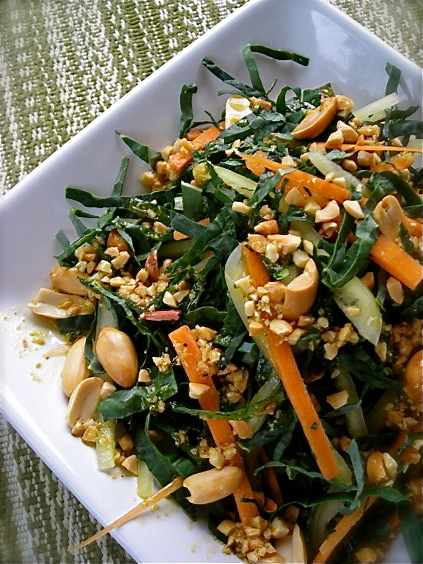
And this slaw was only for my eyes, really. I wasn’t making it for a magazine shoot, a fancy dinner or company at my house. But in creating something lovely, just for myself, I am raising the bar on my meals from a routine and mundane thing to a meal wtih some elegance. It didn’t have to be this good. I didn’t have to hone my chef’s knife before taking on the kale. I didn’t need to carefully slice the carrot and pepper. It didn’t have to be perfect.
But piled on a plate and dotted with crushed and whole peanuts, this Kale slaw, with it’s peanut dressing, was a thing of beauty. The dark rich green of the kale, the sharp orange carrot and pale white heirloom pepper, all snapped out from under the blade of my knife without much thought. And that’s part of the appeal. This wasn’t any special consideration. It just happens like this in my kitchen as a matter of fact. I’ve got amazing knife skills, and it isn’t something to hide, really. It’s something to share, to rejoice about and to say ‘Hey, look at that. Isn’t it pretty?’ Because it is. And it was worth all the pain in my hands, the stiff fingers and the endless amounts of hours put in to make it that way. It raises the bar on a simple meal, eaten at my patio table with a pretty basic glass of wine. It makes a Saturday evening alone just that much more fun and exciting.

Those of you who know me outside of this site know I am not very boastful. I’m not one to accept praise all that often, but you put a knife in my hands and I’m going to show you what I can do because this is a skill I am proud of, and one that didn’t come easily. I have pretty severe repetitive stress injuries in both my wrists, and learning to do this in school was torturous and sometimes left me in tears, with my pained hands resting in ice water to reduce the inflammation. My work at the golf club was often hampered by this affliction, but to hear the chef comment on how nice my vegetable trays looked made the discomfort worthwhile, even as I bit back the pain and went home to ice baths and Advil.
I love the earthy crunch to this slaw and the nutty flavor of the dressing. The kale isn’t cooked, but the dressing soaks in to it and softens the texture nicely. I used lacinato kale and loved the dark color against the carrot and pepper. I think some red cabbage in this would be very pretty too, or the lighter frilly green of Savoy. If you don’t care for peanuts or can’t have them, try using almonds, or pecans. One nice aspect of this recipe, and using raw kale is that even the next day there’s no soggy leaves. The sturdy kale can withstand an overnight, bathed in this nice dressing and still maintain good crunch for lunch on the second day. The overall flavor of the salad was richer, and more pronounced too.
Kale Slaw with Peanut Dressing
2 large bunches of kale, either lacinato or curly, washed and spun dry
2 medium red pepper, sliced very thin
2 carrots, peeled and sliced lengthwise
1 c. roasted peanuts
1/4 c. olive oil
2 T. apple cider vinegar
1 T. packed brown sugar
1/4 t. sea salt
Pinch of red pepper flakes
Fold kale leaves in half and tear out tough stems. Roll leaves tightly and slice thinly into very fine ribbons. Toss kale in a bowl with the pepper, carrot and half a cup of whole peanuts.
In a measuring cup, whisk the oil, vinegar, sugar, salt and pepper flakes. Using a food chopper or small food processor, chop the remaining half cup of peanuts into mostly fine pieces. Remove from chopper and add 2-3 tablespoons of them to the dressing, and whisk to mix. Pour dressing over kale, toss to coat and allow to sit for 10-15 minutes. Toss again and serve, sprinkled with remaining crushed peanuts.
August 1st, 2009
| 8 Comments »
Are you a one-track mind kind of person when it comes to your salad? Does it have to be green, with cukes, tomato, a hard crouton or two and some type of dressing or it can’t possibly be a salad?
If that’s the case, then you might want to skip this post.
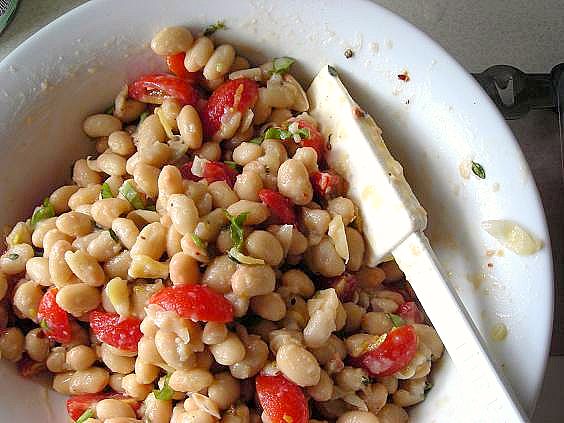 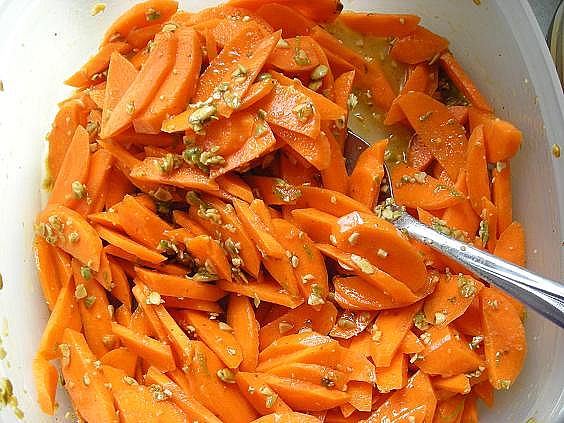 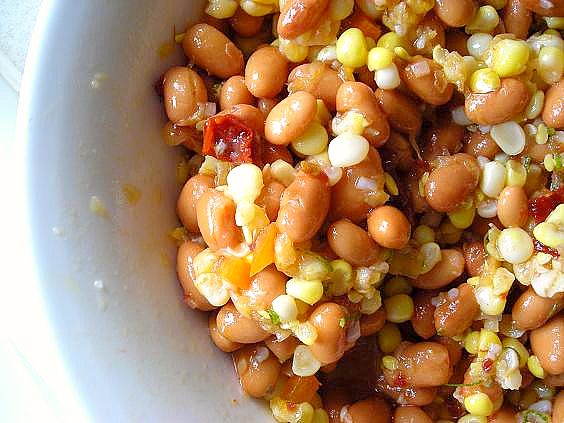
While I certainly have enjoyed my share of salads this summer, resplendent with leafy field greens, dark spinach leaves and all manner of vegetable toppings and extras, I serendipitously came across the be-all to end-all of salad options recently that has thoroughly taken my mind off the standard greens and placed it smack in the middle of Salad Experimentation Land just as the peak of summer produce has me reeling with endless possibilities.
Each of these salads took about 10 minutes to put together, if even that. And every one of them simply shouted with flavor.
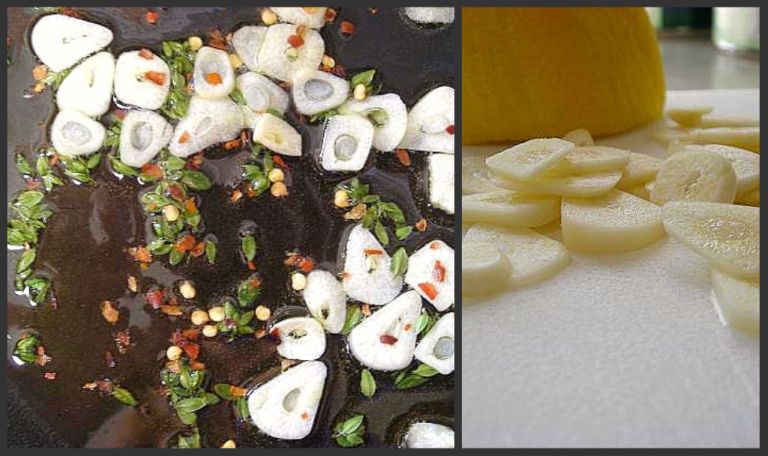 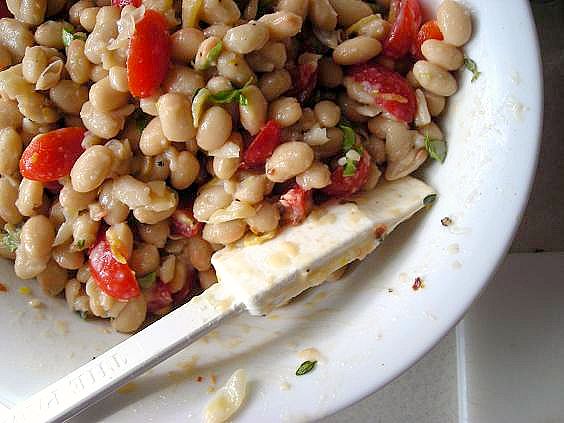
Lemony Garlic White Beans
1 15-oz can great northern or cannelini beans, rinsed well
2 cloves garlic, thin sliced
2 t. fresh thyme leaves
1 t. crushed red pepper
2-3 T. fresh basil leaves, chopped
Juice of one lemon, zest of half the lemon
1/2 c. grape tomato, halved (more if desired)
Olive oil, salt and pepper
In a medium bowl, combine beans, tomato, lemon zest and basil leaves. In a small skillet, warm olive oil slowly with thyme leaves and crushed pepper. When hot and leaves are sizzling slightly, add garlic slices and cook gently until lightly browned. Stir in lemon juice, then pour over beans and stir carefully to combine. Mash some of the beans slightly and season with salt and pepper. Add more oil if too dry. Chill for an hour or two, then stir before serving. Can be eaten alone, a topping for toasted bread or a filling for an omelet.
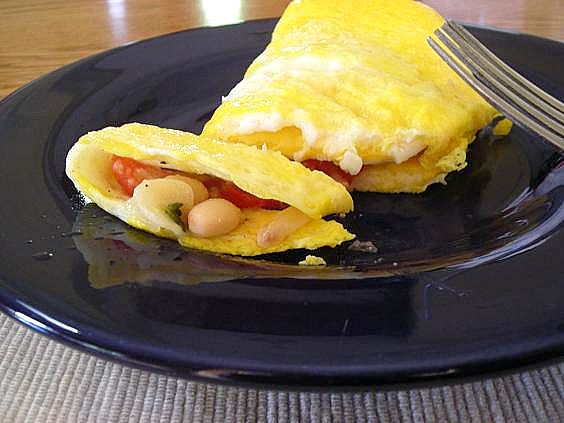
Lime Infused Carrots
3-4 medium carrots, scrubbed, peeled and thinly sliced (or grated if you want)
juice and zest of one lime
3-4 T. olive oil
1/2 c. crushed pumpkin seeds (pepitas)
Combine carrots, juice, zest and oil in a bowl. Season with salt and pepper and stir in pepitas. Allow to chill before serving.
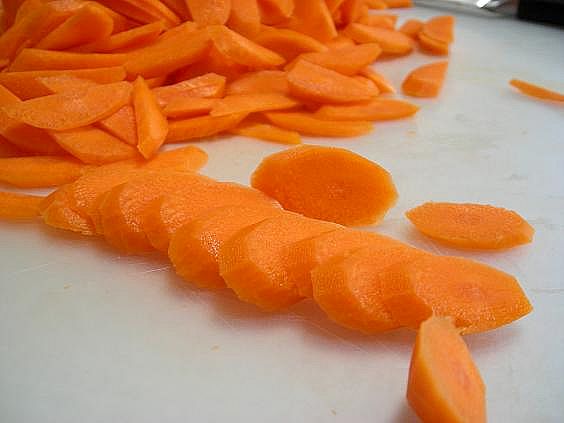
Chipotle Corn and Pinto Beans
1 15-oz can pinto beans, rinsed well
3 ears of fresh sweet corn kernels
1 T. chipotle pepper with adobo (more if you like the heat)
1/2 sweet pepper, any color- minced
1 small shallot, minced
Zest and juice of one lime
1/2 c. cilantro, rough chopped
Olive oil, salt and pepper to taste
Combine all ingredients in a bowl and stir well. Season with salt and pepper and chill for about an hour. Taste before serving and adjust seasonings if needed.

This is just a sampling of the 101 salad options I found. The best part of it all is that the suggestions are just baselines for your imagination. That carrot recipe was an off-shoot of the original listed, and the Chipotle Corn salad didn’t have either shallot or sweet pepper in it, but I had them on hand and knew they’d be excellent. The bottom line is simple; the recipes are perfect just the way they are. They’re so easy that cooking skills aren’t even seriously required, but if you’ve got the wherewithal to spark some alternatives, add something with extra pizazz or just take it in a whole new direction, then you could spend now until the coming of winter playing with this list. What are you waiting for? It’s already August!!
|















